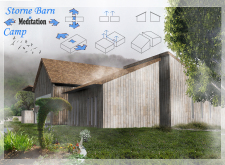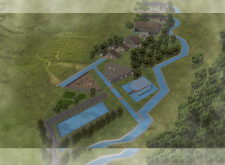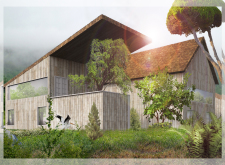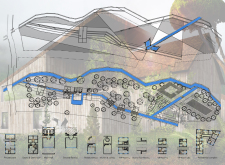5 key facts about this project
The architecture of the Storne Barn is characterized by its use of natural materials, primarily wood, which forms both the structure and the aesthetic expression of the buildings. Wood's texture and warmth establish a sense of comfort and familiarity, echoing the rural context in which the camp is set. Alongside wood, the use of glass plays a crucial role in the design. Large windows are strategically placed throughout the buildings, allowing natural light to flood the interior spaces and providing unobstructed views of the landscape. This connection to the outside contributes not only to the aesthetic quality of the interiors but also to the overall sense of calm and well-being that the project aims to promote.
Significantly, the roofs of the structures feature distinct gabled forms, which not only add visual interest but also facilitate natural ventilation and airflow. This design choice is particularly beneficial in creating a comfortable indoor climate throughout the year. The arrangement of buildings on the site is deliberative, with pathways designed to guide visitors through varied experiences, from quiet meditation to social interaction. The presence of water features, such as streams or ponds, further enriches the environment, enhancing the sensory experience and offering a soothing auditory backdrop that complements the intention of the camp.
The diversity of spaces within the Storne Barn Meditation Camp is thoughtfully considered. Communal gathering spaces, such as the main hall and dining area, encourage social interaction and shared experiences. In contrast, meditation rooms and saunas provide the necessary solitude for personal reflection, accommodating the varied needs of visitors. This juxtaposition between communal and private spaces is key to the camp’s overall functionality, making it a versatile retreat.
One of the unique design approaches observed is the careful landscaping surrounding the buildings. Indigenous plants are thoughtfully incorporated into the design, contributing to the biodiversity of the area while enhancing the overall aesthetic appeal. The landscaping serves a dual purpose, providing visual beauty and promoting an ecosystem that contributes to the sustainability of the site.
In addition to its architectural features, the Storne Barn Meditation Camp places a strong emphasis on environmental responsibility. The choice of sustainable materials and the integration of natural landscapes signify a commitment to minimizing the ecological footprint. This conscientious approach not only aligns with contemporary architectural ideals but also resonates deeply with the camp's purpose as a sanctuary for mindfulness.
Overall, the Storne Barn Meditation Camp stands as a compelling case study in contemporary architecture that values the importance of place, community, and sustainability. Its design successfully merges functional requirements with aesthetic sensibilities, resulting in a space where users can explore meditation and self-discovery amidst a supportive environment.
For a comprehensive understanding of the project's architectural plans, sections, and design innovations, readers are encouraged to delve deeper into the presentation, which reveals the ideas and approaches that shape this remarkable retreat.


























